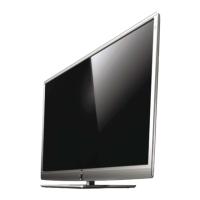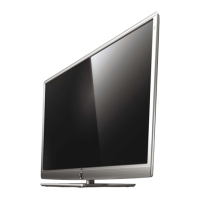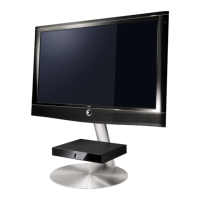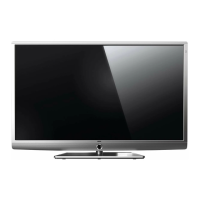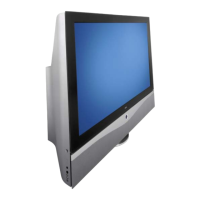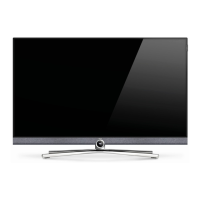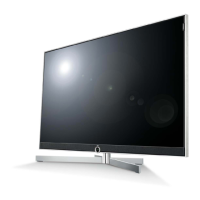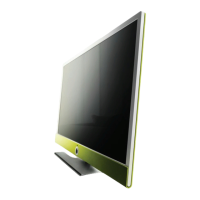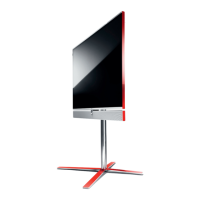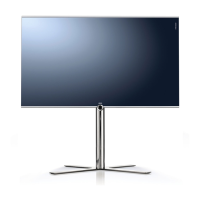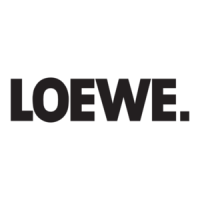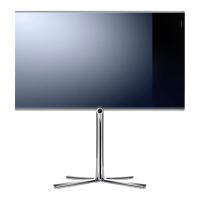Do you have a question about the Loewe Art 55 and is the answer not in the manual?
Information on how to use this guide, including symbols and terms.
Lists all items included in the TV set packaging.
Manufacturer details and contact information.
Covers safe usage, ambient conditions, ventilation, and LCD care.
Guidelines for transporting, power supply safety, and 3D function.
Instructions for setting up the TV, supervision, and volume safety.
Covers automatic shutdown, cleaning, repairs, and technical notes.
Detailed explanation of each button's function on the remote control.
Description of the physical buttons and indicators on the TV itself.
Instructions for inserting batteries into the remote control.
Identifies and describes all ports and connections on the back of the TV.
Guidance on mounting options and initial physical setup.
Instructions for routing and fixing cables for a tidy setup.
Steps for connecting the TV to the mains and antenna sources.
Steps for establishing wired or wireless network connections.
Methods for turning the TV on, off, and into standby mode.
Explains the common layout and components of TV menu screens.
How to navigate menus and enter data using the remote.
Illustrates typical settings screens for picture adjustments.
Methods for inputting text using on-screen or remote controls.
Details on various information displays shown on the screen.
How to control basic TV functions using physical buttons.
Step-by-step guide for the initial TV setup process.
Options for optimizing power consumption and display modes.
Selecting TV location for proper channel sorting and tuning.
How to access, create, edit, and delete favourite items.
How to access different media sources and inputs.
How to adjust the audio volume level.
Ways to change TV channels using lists or direct input.
How to view and switch between different station lists.
Using advanced lists for filtering, sorting, and searching stations.
Creating and managing custom lists of preferred TV channels.
Explains icons next to station names and access to viewing history.
Interpreting information shown on the TV's status display.
Detailed explanations of symbols for audio and video signals.
Accessing and using the function list for TV mode.
Managing AV inputs and switching between them.
Playing only audio from AV sources with the screen off.
How to browse, filter, and customize the EPG view.
Accessing detailed info, memorizing, and scheduling recordings via EPG.
How to activate, deactivate, and select channels for PIP.
Adjusting PIP size and using color key functions.
How to start, exit, and browse teletext pages.
Methods for selecting teletext pages using keys and symbols.
Accessing interactive content and media text via HbbTV.
Availability and use of HbbTV features with DVB radio stations.
Pausing and resuming live TV broadcasts.
Recording programs to an external USB drive for later viewing.
Methods for initiating recordings immediately or with a set duration.
Watching live TV while a recording is in progress.
How to stop recordings or time shifts prematurely.
Navigating and playing back recorded content from the DR+ archive.
Using multi-select, export, move, and favorite functions for archive entries.
Organizing recordings into custom directories within the DR+ archive.
Watching DR+ content from one TV on another via the network.
Seamlessly continuing TV viewing on a different TV set.
Connecting to and selecting local or network video sources.
Using the function list and playback controls for videos.
Interpreting symbols during video playback for status and options.
Using playback controls like skip, bookmark, and format change.
Navigating quickly within videos using jump features.
Setting, jumping to, deleting, and managing bookmarks in recordings.
Connecting to and selecting music sources like USB, network, and radio.
Using the function list and controls for playing music files.
Understanding status display symbols and playback controls for audio.
Selecting tracks, controlling playback, and using playback modes.
How to access and tune into digital radio stations via DVB.
Selecting stations, using function lists, and screen control.
Connecting to and selecting digital radio stations via the internet.
Using artist search, station search, and playback controls.
Connecting to and selecting sources for viewing photos.
Using the function list, slide shows, and sorting for photos.
Understanding symbols and using controls for viewing photos.
Viewing photos in full-screen, rotating, and managing slide shows.
Navigating and using the MediaNet platform for online content.
Accessing websites using the integrated web browser.
Inputting URLs and navigating web pages.
Understanding browser status symbols and web navigation.
Configuring display settings like contrast, brightness, and format.
Adjusting audio settings such as volume, balance, and output.
Tuning, organizing, and updating TV and radio station lists.
Managing advanced functions like EPG, PIP, network, and system updates.
Configuring external devices and accessing additional TV features.
Adding, deleting, or changing timer recordings and alarms.
Using the TV for alarm functions and scheduling events.
Procedures for downloading and installing software updates using a USB stick.
Specifications and preparation needed for USB sticks used for updates.
Installing and using a CA module for scrambled digital channels.
Customizing the function of the dedicated Web key on the remote.
Details about the TV's built-in hardware and software capabilities.
Guidelines for using third-party mounting options according to VESA standards.
Information on user manuals, conformity, and manufacturer declarations.
Detailed technical data including dimensions, weight, and power usage.
Information on energy saving features and power management.
Instructions for responsible disposal of the TV set and batteries.
Legal information regarding software used in the device.
Contact information for Loewe service centers worldwide.
Information on how to use this guide, including symbols and terms.
Lists all items included in the TV set packaging.
Manufacturer details and contact information.
Covers safe usage, ambient conditions, ventilation, and LCD care.
Guidelines for transporting, power supply safety, and 3D function.
Instructions for setting up the TV, supervision, and volume safety.
Covers automatic shutdown, cleaning, repairs, and technical notes.
Detailed explanation of each button's function on the remote control.
Description of the physical buttons and indicators on the TV itself.
Instructions for inserting batteries into the remote control.
Identifies and describes all ports and connections on the back of the TV.
Guidance on mounting options and initial physical setup.
Instructions for routing and fixing cables for a tidy setup.
Steps for connecting the TV to the mains and antenna sources.
Steps for establishing wired or wireless network connections.
Methods for turning the TV on, off, and into standby mode.
Explains the common layout and components of TV menu screens.
How to navigate menus and enter data using the remote.
Illustrates typical settings screens for picture adjustments.
Methods for inputting text using on-screen or remote controls.
Details on various information displays shown on the screen.
How to control basic TV functions using physical buttons.
Step-by-step guide for the initial TV setup process.
Options for optimizing power consumption and display modes.
Selecting TV location for proper channel sorting and tuning.
How to access, create, edit, and delete favourite items.
How to access different media sources and inputs.
How to adjust the audio volume level.
Ways to change TV channels using lists or direct input.
How to view and switch between different station lists.
Using advanced lists for filtering, sorting, and searching stations.
Creating and managing custom lists of preferred TV channels.
Explains icons next to station names and access to viewing history.
Interpreting information shown on the TV's status display.
Detailed explanations of symbols for audio and video signals.
Accessing and using the function list for TV mode.
Managing AV inputs and switching between them.
Playing only audio from AV sources with the screen off.
How to browse, filter, and customize the EPG view.
Accessing detailed info, memorizing, and scheduling recordings via EPG.
How to activate, deactivate, and select channels for PIP.
Adjusting PIP size and using color key functions.
How to start, exit, and browse teletext pages.
Methods for selecting teletext pages using keys and symbols.
Accessing interactive content and media text via HbbTV.
Availability and use of HbbTV features with DVB radio stations.
Pausing and resuming live TV broadcasts.
Recording programs to an external USB drive for later viewing.
Methods for initiating recordings immediately or with a set duration.
Watching live TV while a recording is in progress.
How to stop recordings or time shifts prematurely.
Navigating and playing back recorded content from the DR+ archive.
Using multi-select, export, move, and favorite functions for archive entries.
Organizing recordings into custom directories within the DR+ archive.
Watching DR+ content from one TV on another via the network.
Seamlessly continuing TV viewing on a different TV set.
Connecting to and selecting local or network video sources.
Using the function list and playback controls for videos.
Interpreting symbols during video playback for status and options.
Using playback controls like skip, bookmark, and format change.
Navigating quickly within videos using jump features.
Setting, jumping to, deleting, and managing bookmarks in recordings.
Connecting to and selecting music sources like USB, network, and radio.
Using the function list and controls for playing music files.
Understanding status display symbols and playback controls for audio.
Selecting tracks, controlling playback, and using playback modes.
How to access and tune into digital radio stations via DVB.
Selecting stations, using function lists, and screen control.
Connecting to and selecting digital radio stations via the internet.
Using artist search, station search, and playback controls.
Connecting to and selecting sources for viewing photos.
Using the function list, slide shows, and sorting for photos.
Understanding symbols and using controls for viewing photos.
Viewing photos in full-screen, rotating, and managing slide shows.
Navigating and using the MediaNet platform for online content.
Accessing websites using the integrated web browser.
Inputting URLs and navigating web pages.
Understanding browser status symbols and web navigation.
Configuring display settings like contrast, brightness, and format.
Adjusting audio settings such as volume, balance, and output.
Tuning, organizing, and updating TV and radio station lists.
Managing advanced functions like EPG, PIP, network, and system updates.
Configuring external devices and accessing additional TV features.
Adding, deleting, or changing timer recordings and alarms.
Using the TV for alarm functions and scheduling events.
Procedures for downloading and installing software updates using a USB stick.
Specifications and preparation needed for USB sticks used for updates.
Installing and using a CA module for scrambled digital channels.
Customizing the function of the dedicated Web key on the remote.
Details about the TV's built-in hardware and software capabilities.
Guidelines for using third-party mounting options according to VESA standards.
Information on user manuals, conformity, and manufacturer declarations.
Detailed technical data including dimensions, weight, and power usage.
Information on energy saving features and power management.
Instructions for responsible disposal of the TV set and batteries.
Legal information regarding software used in the device.
Contact information for Loewe service centers worldwide.
| Screen shape | Flat |
|---|---|
| Response time | 6 ms |
| Display diagonal | 55 \ |
| Display brightness | 450 cd/m² |
| Native refresh rate | 200 Hz |
| LED backlighting type | Edge-LED |
| Display diagonal (metric) | 140 cm |
| Motion interpolation technology | - |
| 3D | Yes |
| Annual energy consumption | 232 kWh |
| Tuner type | Analog & digital |
| Digital signal format system | DVB-C, DVB-C2, DVB-S2, DVB-T2 |
| Audio decoders | Dolby Digital, Dolby Digital Plus |
| RMS rated power | 40 W |
| Number of speakers | 2 |
| HDMI ports quantity | 4 |
| USB 2.0 ports quantity | USB 2.0 ports have a data transmission speed of 480 Mbps, and are backwards compatible with USB 1.1 ports. You can connect all kinds of peripheral devices to them. |
| S-Video inputs quantity | 0 |
| USB 3.2 Gen 1 (3.1 Gen 1) Type-A ports quantity | 1 |
| Video formats supported | H.264, H.265, MPEG, MPEG2, MPEG4 |
| Product color | Black |
| Panel mounting interface | 400 x 400 mm |
| AC input voltage | 220 - 240 V |
| AC input frequency | 50 - 60 Hz |
| Power consumption (off) | 0 W |
| Power consumption (standby) | 0.38 W |
| Power consumption (typical) | 167 W |
| Weight (without stand) | 30800 g |
|---|
